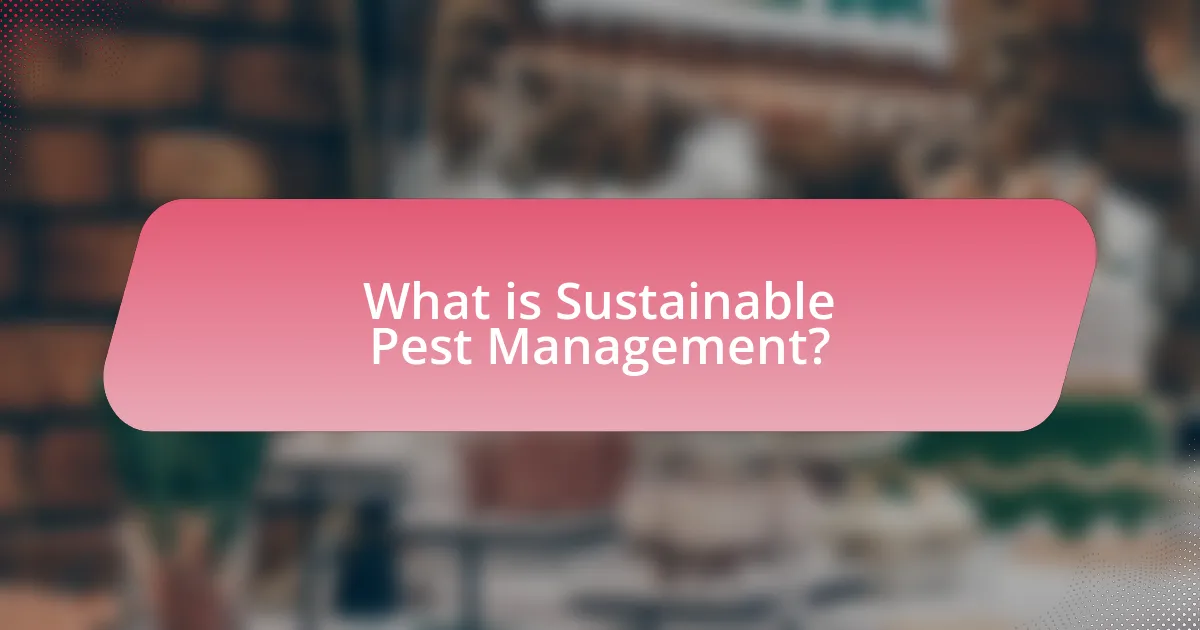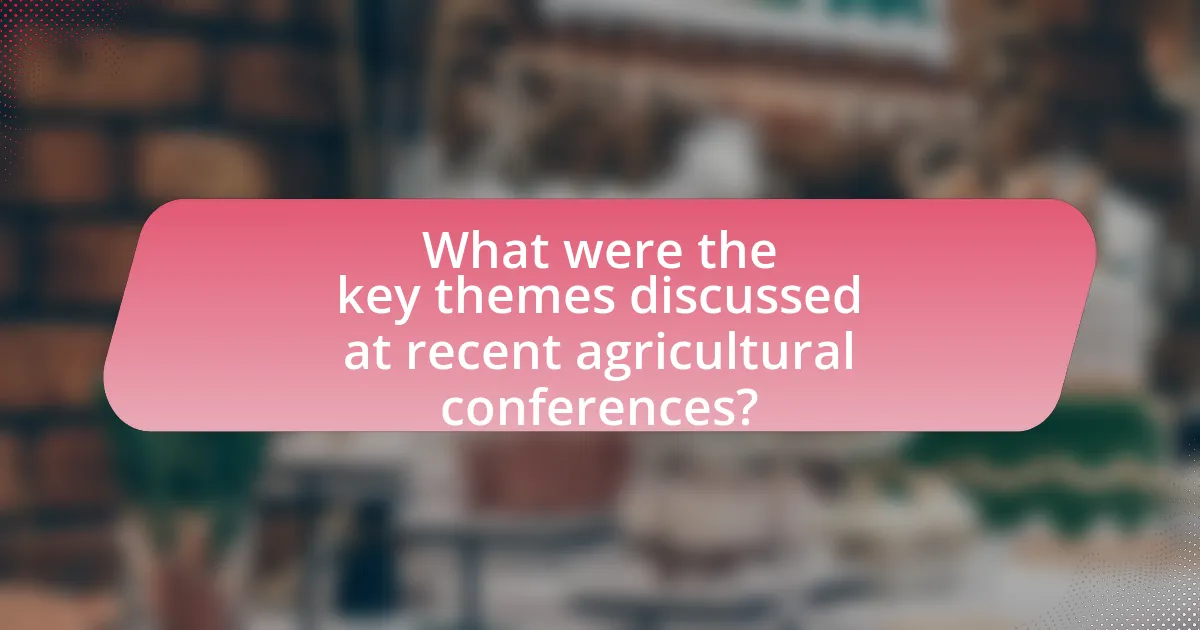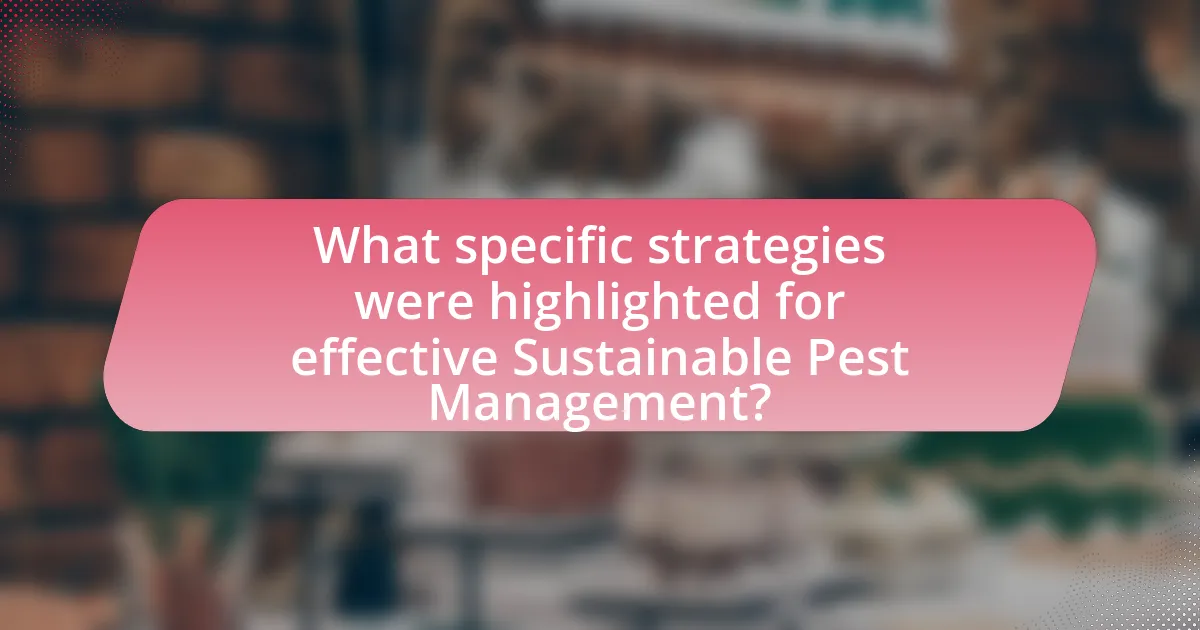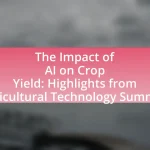Sustainable Pest Management (SPM) is an ecological approach aimed at controlling pest populations while minimizing environmental impact and promoting agricultural productivity. This article explores the differences between SPM and traditional pest control methods, emphasizing the integration of biological control, habitat manipulation, and resistant plant varieties. Key principles of SPM, innovations in technology, and collaborative efforts among researchers, farmers, and technology companies are discussed, highlighting successful case studies and the challenges faced in adopting sustainable practices. The article also outlines effective strategies for implementing Integrated Pest Management (IPM) techniques and the benefits of monitoring and assessment in enhancing pest management outcomes across various crops.

What is Sustainable Pest Management?
Sustainable Pest Management is an ecological approach to controlling pest populations that minimizes environmental impact while promoting agricultural productivity. This method integrates various strategies, including biological control, habitat manipulation, and the use of resistant plant varieties, to manage pests in a way that is economically viable and environmentally sound. Research indicates that sustainable practices can reduce pesticide use by up to 50%, thereby decreasing chemical runoff and enhancing biodiversity in agricultural ecosystems.
How does Sustainable Pest Management differ from traditional methods?
Sustainable Pest Management (SPM) differs from traditional methods primarily in its holistic approach, emphasizing ecological balance and long-term solutions over short-term pest control. Traditional methods often rely heavily on chemical pesticides, which can lead to environmental degradation and pest resistance. In contrast, SPM incorporates a variety of strategies, including biological control, habitat manipulation, and the use of resistant crop varieties, aiming to minimize chemical use and enhance biodiversity. Research indicates that SPM practices can reduce pesticide use by up to 50% while maintaining crop yields, demonstrating their effectiveness and sustainability compared to conventional methods.
What are the key principles of Sustainable Pest Management?
The key principles of Sustainable Pest Management include integrated pest management (IPM), ecological balance, and the use of biological control methods. Integrated pest management emphasizes the combination of biological, cultural, physical, and chemical tools to manage pest populations effectively while minimizing risks to human health and the environment. Ecological balance focuses on maintaining the natural ecosystem’s health to prevent pest outbreaks, while biological control methods involve using natural predators or parasites to control pest populations. These principles are supported by research indicating that sustainable practices can reduce pesticide use by up to 50% and enhance biodiversity in agricultural systems.
Why is Sustainable Pest Management important for agriculture?
Sustainable Pest Management is important for agriculture because it enhances crop productivity while minimizing environmental impact. This approach reduces reliance on chemical pesticides, which can lead to soil and water contamination, and promotes biodiversity by protecting beneficial organisms. Research indicates that sustainable practices can increase yields by up to 20% while decreasing pest-related losses, thereby supporting food security and economic viability for farmers.
What innovations are emerging in Sustainable Pest Management?
Innovations in Sustainable Pest Management include the use of biopesticides, integrated pest management (IPM) strategies, and precision agriculture technologies. Biopesticides, derived from natural materials, are gaining traction due to their effectiveness and reduced environmental impact. Integrated pest management combines biological, cultural, and chemical practices to minimize pest populations sustainably. Precision agriculture employs data analytics and technology to optimize pest control measures, ensuring targeted application and reducing chemical use. These innovations are supported by research indicating that biopesticides can reduce pest populations by up to 50% while maintaining crop yields, demonstrating their efficacy and sustainability in agricultural practices.
How are technology and research contributing to these innovations?
Technology and research are significantly enhancing sustainable pest management innovations by providing advanced tools and methodologies for pest control. For instance, precision agriculture technologies, such as drones and satellite imagery, enable farmers to monitor pest populations and crop health in real-time, leading to targeted interventions that minimize pesticide use. Research studies, such as those published in the Journal of Integrated Pest Management, demonstrate that integrating biological control methods with these technologies can reduce reliance on chemical pesticides by up to 50%, showcasing the effectiveness of combining innovative technology with scientific research in developing sustainable practices.
What role do biological control methods play in these innovations?
Biological control methods play a crucial role in sustainable pest management innovations by utilizing natural predators, parasites, or pathogens to manage pest populations effectively. These methods reduce reliance on chemical pesticides, thereby minimizing environmental impact and promoting biodiversity. For instance, the introduction of ladybugs for aphid control exemplifies how biological agents can maintain pest populations at manageable levels while preserving ecosystem health. Research indicates that biological control can lead to a 50-90% reduction in pest populations, demonstrating its effectiveness and sustainability in agricultural practices.

What were the key themes discussed at recent agricultural conferences?
Key themes discussed at recent agricultural conferences included sustainable pest management practices, technological innovations in agriculture, and the integration of ecological principles into farming. These themes reflect a growing emphasis on reducing chemical pesticide use and promoting biodiversity. For instance, conferences highlighted the use of biopesticides and integrated pest management (IPM) strategies, which have been shown to reduce pest populations while minimizing environmental impact. Additionally, advancements in precision agriculture technologies, such as drones and data analytics, were showcased as tools to enhance pest monitoring and management efficiency.
How are experts defining the future of Sustainable Pest Management?
Experts define the future of Sustainable Pest Management as a holistic approach that integrates advanced technologies, ecological principles, and stakeholder collaboration to minimize pest-related damage while reducing environmental impact. This definition is supported by recent advancements in precision agriculture, which utilize data analytics and remote sensing to optimize pest control measures, thereby enhancing efficiency and sustainability. Additionally, the adoption of biopesticides and integrated pest management strategies is gaining traction, as evidenced by findings presented at agricultural conferences, highlighting their effectiveness in reducing chemical pesticide reliance and promoting biodiversity.
What case studies were presented that highlight successful implementations?
The case studies presented that highlight successful implementations in sustainable pest management include the use of integrated pest management (IPM) strategies in California vineyards, which resulted in a 30% reduction in pesticide use while maintaining grape yield and quality. Another notable case study is the adoption of biocontrol agents in organic vegetable farms in Florida, leading to a 50% decrease in pest-related crop losses. These examples demonstrate effective applications of sustainable practices that enhance agricultural productivity and environmental health.
What challenges were identified in adopting new practices?
Challenges identified in adopting new practices in sustainable pest management include resistance to change among farmers, lack of access to information and resources, and insufficient training on new techniques. Resistance to change is often rooted in established habits and skepticism about the effectiveness of new methods. Additionally, many farmers face barriers such as limited access to the latest research or technology, which hinders their ability to implement innovative practices. Training gaps further complicate adoption, as farmers may not receive adequate education on how to effectively utilize new pest management strategies. These challenges collectively impede the transition to more sustainable agricultural practices.
What collaborative efforts are being made in the field?
Collaborative efforts in sustainable pest management are being made through partnerships between agricultural researchers, universities, and industry stakeholders. These collaborations focus on sharing innovative practices and technologies that enhance pest control while minimizing environmental impact. For instance, the recent Agricultural Innovations Conference highlighted joint research initiatives aimed at developing integrated pest management strategies that leverage biological control methods and precision agriculture techniques. Such partnerships not only facilitate knowledge exchange but also promote the adoption of sustainable practices across various agricultural sectors, as evidenced by the participation of over 300 experts from different organizations in the conference.
How are universities and research institutions contributing to Sustainable Pest Management?
Universities and research institutions are significantly contributing to Sustainable Pest Management by conducting innovative research and developing integrated pest management strategies. These institutions focus on biological control methods, such as utilizing natural predators and parasitoids, which have been shown to reduce pest populations effectively without harming the environment. For instance, studies from the University of California have demonstrated that introducing beneficial insects can lead to a 50% reduction in pest populations in agricultural settings. Additionally, universities are involved in educating farmers about sustainable practices, providing them with the latest research findings and tools to implement eco-friendly pest management solutions. This collaboration between academia and agriculture fosters the adoption of sustainable techniques, ultimately leading to more resilient farming systems.
What partnerships are forming between farmers and technology companies?
Partnerships are forming between farmers and technology companies focused on sustainable pest management solutions. These collaborations often involve the integration of precision agriculture technologies, such as drones, IoT sensors, and data analytics, to enhance pest monitoring and control. For instance, companies like Bayer and Microsoft have teamed up to develop digital farming tools that utilize AI and machine learning to optimize pesticide application, thereby reducing chemical use and improving crop yields. Additionally, startups like Taranis are partnering with farmers to provide aerial imagery and analytics that help identify pest infestations early, allowing for timely interventions. These partnerships are driven by the need for more efficient and environmentally friendly agricultural practices, as evidenced by the increasing adoption of technology in farming to address sustainability challenges.

What specific strategies were highlighted for effective Sustainable Pest Management?
Specific strategies highlighted for effective Sustainable Pest Management include integrated pest management (IPM), biological control, and the use of resistant crop varieties. Integrated pest management combines cultural, mechanical, biological, and chemical practices to minimize pest populations while reducing environmental impact. Biological control involves utilizing natural predators or parasites to manage pest populations, which has been shown to reduce reliance on chemical pesticides. The use of resistant crop varieties is a proactive approach that enhances crop resilience against pests, thereby decreasing the need for chemical interventions. These strategies are supported by research indicating that they lead to sustainable agricultural practices and improved ecosystem health.
How can farmers implement Integrated Pest Management (IPM) techniques?
Farmers can implement Integrated Pest Management (IPM) techniques by combining biological, cultural, physical, and chemical tools to manage pest populations effectively. This approach involves monitoring pest levels, identifying pest species, and using thresholds to determine when action is necessary. For instance, farmers can utilize beneficial insects to control pest populations naturally, rotate crops to disrupt pest life cycles, and apply pesticides only when pest levels exceed economic thresholds. Research indicates that IPM can reduce pesticide use by 30-50% while maintaining crop yields, demonstrating its effectiveness in sustainable agriculture.
What are the steps involved in developing an IPM plan?
The steps involved in developing an Integrated Pest Management (IPM) plan include assessing the pest situation, setting action thresholds, monitoring and identifying pests, implementing control measures, and evaluating the effectiveness of the management strategies.
First, assessing the pest situation involves understanding the types of pests present and their potential impact on crops. Next, setting action thresholds helps determine when pest populations reach levels that require management. Monitoring and identifying pests is crucial for accurate decision-making, as it ensures that the correct pests are targeted. Implementing control measures can include a combination of biological, cultural, mechanical, and chemical methods tailored to the specific pest problem. Finally, evaluating the effectiveness of the management strategies allows for adjustments and improvements in the IPM plan over time.
These steps are supported by guidelines from the Environmental Protection Agency, which emphasizes the importance of a systematic approach to pest management that minimizes risks to human health and the environment.
How can monitoring and assessment improve pest management outcomes?
Monitoring and assessment can significantly improve pest management outcomes by providing real-time data that informs decision-making. Accurate monitoring allows for the identification of pest populations and their life cycles, enabling targeted interventions rather than broad-spectrum applications. For instance, studies have shown that integrated pest management (IPM) strategies, which rely on continuous monitoring, can reduce pesticide use by up to 50% while maintaining crop yields. This data-driven approach not only enhances the effectiveness of pest control measures but also minimizes environmental impact, aligning with sustainable agricultural practices.
What best practices were shared for pest control in various crops?
Best practices for pest control in various crops include integrated pest management (IPM), crop rotation, and the use of biological control agents. IPM combines cultural, mechanical, biological, and chemical practices to minimize pest damage while reducing reliance on pesticides. Crop rotation disrupts pest life cycles and reduces the buildup of pest populations. Biological control agents, such as beneficial insects and microorganisms, help manage pest populations naturally. These practices are supported by research indicating that IPM can reduce pesticide use by up to 50% while maintaining crop yields, demonstrating their effectiveness in sustainable agriculture.
Which crops benefit most from Sustainable Pest Management strategies?
Crops that benefit most from Sustainable Pest Management strategies include vegetables, fruits, and grains. These crops are particularly susceptible to pest damage, making effective management essential for maintaining yield and quality. For instance, studies have shown that integrated pest management (IPM) practices can reduce pest populations in tomato and cucumber crops by up to 50%, leading to significant improvements in harvest quality and quantity. Additionally, fruit crops like apples and strawberries have demonstrated enhanced resistance to pests when sustainable practices, such as biological control and crop rotation, are employed. These strategies not only protect the crops but also promote environmental health, making them vital for sustainable agriculture.
What are the common pitfalls to avoid in pest management?
Common pitfalls to avoid in pest management include reliance on a single control method, neglecting to monitor pest populations, and failing to consider the ecological impact of interventions. Relying solely on chemical pesticides can lead to resistance, making pests harder to control over time. Neglecting regular monitoring can result in delayed responses to pest outbreaks, exacerbating infestations. Additionally, not considering the ecological consequences of pest management strategies can harm beneficial organisms and disrupt local ecosystems. These pitfalls are supported by research indicating that integrated pest management approaches, which combine multiple strategies and emphasize monitoring, are more effective and sustainable in the long term.
What practical tips can farmers use to enhance their pest management efforts?
Farmers can enhance their pest management efforts by implementing integrated pest management (IPM) strategies, which combine biological, cultural, physical, and chemical tools. For instance, crop rotation disrupts pest life cycles, while introducing beneficial insects can naturally control pest populations. Research indicates that farms utilizing IPM practices can reduce pesticide use by up to 50%, leading to both economic and environmental benefits. Additionally, monitoring pest populations through traps and scouting helps farmers make informed decisions about when and how to intervene, further optimizing their pest management strategies.















